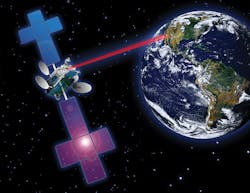DARPA considers small optical sensor using free-space optical technology
ARLINGTON, Va. - U.S. military researchers are asking for industry's help in developing a small, lightweight electro-optical sensor using free-space optical technology with ultra-low size, weight, and cost with much faster beam scanning speeds than are available today.
Officials of the U.S. Defense Advanced Research Projects Agency (DARPA) in Arlington, Va., have released a broad agency announcement (DARPA-BAA-16-13) for the Modular Optical Aperture Building Blocks (MOABB) project.
MOABB seeks to develop technologies for an integrated photonic device that can generate, amplify, transmit, and receive free-space optical radiation over a wide angle. Researchers eventually would like to demonstrate this technology in a light detection and ranging (LIDAR) system.
DARPA researchers want to build planar, millimeter-scale transmit/receive units with a high fillfactor aperture, non-mechanical beam steering, and integrated amplification. Their goal is to tile the unit cells to assemble a large coherent higher-power aperture.
The program ultimately seeks to fabricate a coherent 10-centimeter transmit/receive array with distributed gain built with wafer-scale processing, and demonstrate the coherent array in a packaged LIDAR system capable of 3D imaging from as far away as 100 meters.
Free-space optical systems have tremendous potential for sensing, illumination, and communications, DARPA scientists say. The micron- scale wavelength allows for 0.001- degree angular resolution and antenna gain of more than 100 decibels from a modest 10-centimeter aperture.
The frequency in the hundreds of terahertz range and wide operating bandwidths enable high-speed data transmission and 3D imaging with sub-millimeter range resolution. Optical beams also have wide windows of low atmospheric absorption for long-range propagation over terahertz of open bandwidth.
Applications for these features span the space from 3D mapping, foliage penetrating LIDAR, navigation, and long-range communications.
While free-space optical systems offer compelling capabilities, they are too big, heavy, and expensive for many applications. Above a 10- centimeter aperture, their size and weight are dominated by the bulky lenses, mirrors, stabilized mechanical components, and large volume of empty space of the telescope or imaging system.
On the other hand, aperture smaller than 10 centimeters still require bulky mechanical gimbals to steer the telescope and the back-end optics like lasers and detectors.
Instead, DARPA scientists want to capitalize on recent developments in integrated photonics that offer the potential for high-speed, non-mechanical beam-steering. Researchers believe that efficient sources, detectors, amplifiers, and low-loss waveguides can be fabricated on one planar platform for high-power, large-scale apertures.
The MOABB program has two technical areas: technologies for a tileable optical array element for operation in the short-wave infrared band, and a packaged LIDAR system that demonstrates the utility of this kind of technology.
The 21-month first phase of the MOABB program will address the modular transmit and receive unit cells. The second, 18-month phase will develop the unit cell efficiency and fill-factor. The 21-month, third phase will 100-square-inch transmit and receive apertures. Several contract awards are expected.
Companies interested should submit proposals no later than 16 Feb. 2016 to the DARPA website at https://baa.darpa.mil. E-mail questions or concerns to DARPA's Joshua Conway at [email protected].
More information is online at www.fbo.gov/spg/ODA/DARPA/CMO/DARPA-BAA-16-13/listing.html.

